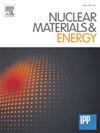熔合材料初始损伤分布和汇的影响:W vs Fe的参数OKMC研究
IF 2.7
2区 物理与天体物理
Q1 NUCLEAR SCIENCE & TECHNOLOGY
引用次数: 0
摘要
众所周知,核试验反应堆和发电厂中的辐照会改变结构材料的性质。采用长时间尺度物体动力学蒙特卡罗模拟,系统研究了不同参数和温度对辐照下钨和铁微观组织演变的影响。我们的研究结果表明,在钨中,球形吸收剂的包裹对于通过限制高移动间隙和空位之间的复合来达到实际的空位饱和水平是必不可少的。在高温下,与随机插入相比,使用级联形插入增强了局部空位簇,导致更多的小空位簇。相反,对于铁,球形吸收剂的缺失有利于不动C15团簇的生长和随后形成< 100 >环,即使在室温下也显著改变缺陷分布。此外,在室温下,剂量率效应可以忽略不计,因为钨中存在不移动的空位和间隙的快速迁移,而在较高温度下,级联之间较长的松弛时间促进了更大空位团簇的发展。这些见解对于动力学蒙特卡罗模型的现实参数化至关重要,有助于更深入地了解核应用中使用的材料的辐照效应。本文章由计算机程序翻译,如有差异,请以英文原文为准。
Influence of initial damage distribution and sinks in fusion materials: A parametric OKMC study of W vs Fe
Irradiation present in nuclear test reactors and power plants is known to alter the properties of structural materials. Using long-timescale Object Kinetic Monte Carlo simulations, we systematically investigated the influence of different parameters and temperature on the microstructural evolution of tungsten and iron under irradiation. Our results indicate that in tungsten, the inclusion of spherical absorbers is essential for achieving realistic vacancy saturation levels by limiting the recombination between highly mobile interstitials and vacancies. At elevated temperatures, using cascade-shaped insertion enhances local vacancy clustering, leading to a larger number of smaller vacancy clusters compared to random insertion. In contrast, for iron, the absence of spherical absorbers facilitates the growth of immobile C15 clusters and subsequent formation of loops, markedly altering the defect distribution even at room temperature. Additionally, while the dose rate effect is negligible at room temperature in tungsten due to the immobile vacancies and the very fast migration of interstitials, longer relaxation times between cascades at higher temperatures promote the development of larger vacancy clusters. These insights are crucial for realistic parameterization of Kinetic Monte Carlo models and contribute to a deeper understanding of the irradiation effects in materials used in nuclear applications.
求助全文
通过发布文献求助,成功后即可免费获取论文全文。
去求助
来源期刊

Nuclear Materials and Energy
Materials Science-Materials Science (miscellaneous)
CiteScore
3.70
自引率
15.40%
发文量
175
审稿时长
20 weeks
期刊介绍:
The open-access journal Nuclear Materials and Energy is devoted to the growing field of research for material application in the production of nuclear energy. Nuclear Materials and Energy publishes original research articles of up to 6 pages in length.
 求助内容:
求助内容: 应助结果提醒方式:
应助结果提醒方式:


